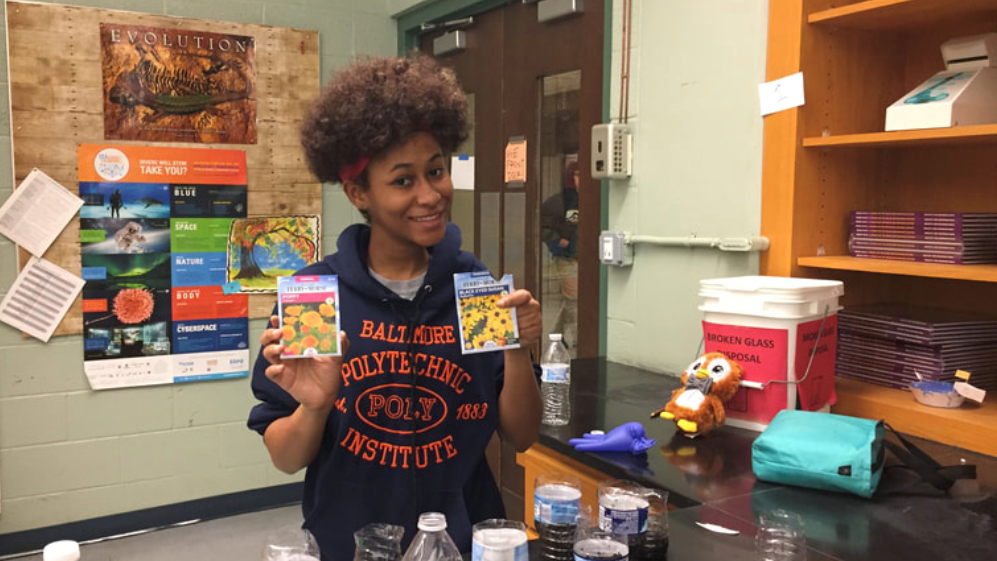Promote Native Plants

Native plants are plants that occur naturally in a region. These plants are adapted to local soil conditions, weather, precipitation, and wildlife. Native plants require less work and support a healthy watershed. Since native plants are adapted to local conditions they don’t require fertilizers and pesticides to keep them healthy which means less chemicals and nutrients entering our waterways. Native plants are also required for a healthy and sustainable food web. Wildlife have adapted to these plants and depend on them for food and shelter.
As the population of the Chesapeake Bay watershed continues to grow and important habitats like forests and wetlands are lost to development and threatened by invasive species, it is increasingly more important to choose native plants when planting a garden or restoring a habitat.
Connecting to Issue Investigation
Many different types of investigations can lead to solutions involving native plants. Habitat and wildlife surveys can show the need for more shelter and food provided by native plants. Investigations exploring the human health benefits of nature can result in community tree plantings and public garden revitalizations. Water quality tests revealing high levels of chemicals and nutrients can lead to a campaign to reduce fertilizer and pesticide use in lawns by planting natives.
For those working towards green school awards, this action can reduce a school’s environmental impact and costs because native plants require less maintenance and learning about the importance of native plants can advance environmental and sustainability education.
Facilitating Student Action
Students should continue to have opportunities to share ideas and opinions throughout the process of identifying, planning, and implementing action. Listed here are just a few ways students can stay engaged while working on this solution—but there are many more! The complexity of each activity/task can be adjusted for each grade level.
- Protect - students can identify healthy habitats in their communities and advocate for their protection and maybe expansion! Students of any age can write letters to the habitat owner. If public space is being threatened, students can submit their opinions to the town or county councils.
- Restore - students can work on restoring a local habitat with native plants. A restoration may first require the removal of invasive plant species. Using age-appropriate resources, students can identify invasive plants, remove them or find volunteers to help, and suggest native plant replacements.
- Create - native plants can also be found in public or schoolyard gardens. If a school is prepared to maintain a native plant garden, students can get involved with school staff to identify an area and create a maintenance plan. Using age-appropriate resources, students can identify the right native plants for their garden’s location.
- Educate - students can educate others on why choosing and protecting native plants supports a healthy ecosystem. Depending on the age of students, this can take many forms from pamphlets, letters, skits, signs, and posters. Education can also include local nurseries. Students can ask nurseries to offer more native plants, suggest native plant alternatives to nonnative ornamental plants, and educate their patrons on the benefits of planting natives.
- Advocate - students can reach out to decision makers and request the use of native plants. These decision makers can be at their school, school district, a homeowner’s association, or the town and county government. Students can write letters or present to these decision makers requesting that all future plantings are native species.
- Monitor - students can monitor a habitat with native plants and, if possible, compare it to an area with nonnative plants. Monitoring can happen with students of all ages. Students can count the number of insects, birds and other wildlife found.
- Share and Celebrate - students can share their work with the school community by giving tours of gardens or habitats, giving presentations, creating displays, or writing and delivering morning announcements. Students can also write articles, press releases or invite reporters from the school paper and the local newspaper.
Native Plant Resources
Native Plant Lists—these are all useful resources but each provides a slightly different experience, find the one that works best for you.
- The U.S. Fish & Wildlife Service Native Plants for Wildlife Habitat and Conservation Landscaping Chesapeake Bay Watershed is an excellent resource for quickly finding if a plant is native to the Chesapeake Bay watershed. Each plant is listed with a picture, its characteristics, growing conditions and additional information. If you can get a hold of a hardcopy of this resource, it can be useful while visiting nurseries or having students research native plant options.
- The user-friendly Native Plant Database from the National Audubon Society is a great search engine for native plants. Simply type in your zip code and scroll through plants for your area. Each plant includes a picture, description and lists the birds it might attract.
- The Chesapeake Bay Native Plant Center allows you to search for plants using multiple filters like location specifics, desired plant type, and even when the plant blooms and fruits.
Finding native plants can sometimes be challenging. Choose Natives lists nurseries in the Mid-Atlantic that only carry native plants. These nurseries can be few and far between so your best option may be to go to a local nursery with a native plant list in hand. Lastly, review these state-specific resources to find local experts and guides.
